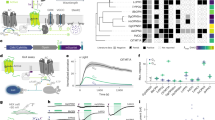Abstract
THE current–voltage relationship provides important information about the mechanism of ionic permeation through membranes. In excitatory synapses the relationship between membrane potential and excitatory postsynaptic current (e.p.s.c.) has been extensively studied using the voltage-clamp method1–6. In the frog endplate it has been shown that the e.p.s.c. was smaller than would be expected from a linear relationship during hyperpolarisation of the membrane3,4. On the other hand, after iontophoretic application of acetylcholine, the synaptic current increased more than expected at hyperpolarised membrane potentials7. In investigating the current–voltage relationship it is important to measure the current on both sides of the equilibrium potential. Inhibitory postsynaptic current (i.p.s.c.) is more suitable for this purpose, because the reversal potential is near the resting potential and so the current–voltage relationship on both sides of the reversal potential can be measured using relatively small potential changes. Little attention has been paid, however, to inhibitory postsynaptic membranes, possibly because the inhibitory synapses are distributed diffusely over the surface of the cell or situated on dendrites remote from the cell body where the electrical changes are measured. In these conditions it is difficult to measure accurately the current–voltage relationship. We have cannulated the opener muscle of the claw in the crayfish (Cambarus clarkii) using a stainless steel wire, the membrane potential being clamped at various levels as described previously6. Although the inhibitory synapses are distributed over the whole surface of the muscle fibre, the space clamp condition of the muscle fibre was maintained well using this technique. We have found that the relationship between membrane potential and i.p.s.c. was highly nonlinear on hyperpolarisation of the membrane.
This is a preview of subscription content, access via your institution
Access options
Subscribe to this journal
Receive 51 print issues and online access
$199.00 per year
only $3.90 per issue
Buy this article
- Purchase on Springer Link
- Instant access to full article PDF
Prices may be subject to local taxes which are calculated during checkout
Similar content being viewed by others
References
Takeuchi, A., and Takeuchi, N., J. Neurophysiol., 22, 395–411 (1959).
Gage, P. W., and Moore, J. W., Science, 166, 510–512 (1969).
Kordaš, M., J. Physiol., Lond., 204, 493–502 (1969).
Magleby, K. L., and Stevens, C. F., J. Physiol., Lond., 223, 151–171 (1972).
Llinás, R., Joyner, R. W., and Nicholson, C., J. gen. Physiol., 64, 510–535 (1974).
Onodera, K., and Takeuchi, A., J. Physiol., Lond., 252, 295–318 (1975).
Dionne, V. E., and Stevens, C. F., J. Physiol., Lond., 251, 245–270 (1975).
Boistel, L., and Fatt, P., J. Physiol., Lond., 144, 176–191 (1958).
Magleby, K. L., and Stevens, C. F., J. Physiol., Lond., 223, 173–197 (1972).
Lassignal, N. L., and Martin, A. R., Science, 191, 464–466 (1976).
Author information
Authors and Affiliations
Rights and permissions
About this article
Cite this article
ONODERA, K., TAKEUCHI, A. Inhibitory postsynaptic current in voltage-clamped crayfish muscle. Nature 263, 153–154 (1976). https://doi.org/10.1038/263153a0
Received:
Accepted:
Issue Date:
DOI: https://doi.org/10.1038/263153a0
This article is cited by
-
The inhibitory chloride channel activated by glutamate as well as?-amino-butyric acid (GABA)
Journal of Comparative Physiology A (1986)
-
Voltage dependence of amplitude and time course of inhibitory synaptic current in crayfish muscle
Pfl�gers Archiv European Journal of Physiology (1977)
Comments
By submitting a comment you agree to abide by our Terms and Community Guidelines. If you find something abusive or that does not comply with our terms or guidelines please flag it as inappropriate.



